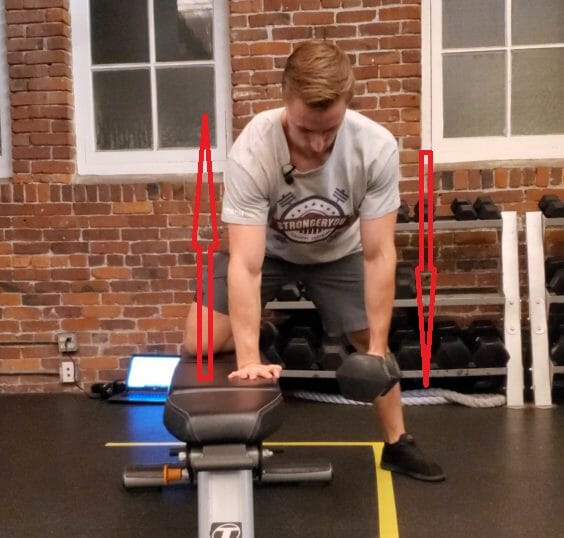Take a look at a lot of the top-level lifters, and you’ll almost always see a strong looking back. Very developed lats are a cornerstone of lifting maximal loads as they are a key contributor to creating “superstiffness” in the spine in order to provide a stable platform to lift from.
One of the best ways to develop your lats on top of general heavy lifting is through rows. Personally, I find that dumbbell rows strike the perfect balance between being well suited to overload, and having a relatively simple technique. That being said, there are a few key points to watch out for when doing dumbbells rows in order to ensure you can personalize the movement to your goals and perform them safely, namely: scapular rhythm, managing rotation, and varying stances.
1) All About Rhythm
With any row movement, if you don’t have good scapular (shoulder blade) movement, you’re dead in the water. We’ve covered scapular packing drills in a previous iteration of Tech Corner. That being said, there are two main ways to train shoulder movement in the row: packed, and dynamic.
In a packed shoulder blade position, you are training the same arm movement as in the bench press – a technique that is very hands for lifters who are still learning how to keep the shoulders in place in the press. By having less moving parts, it can be easier to isolate technique components.
On the other hand, lifters who are more aware of scapular position and looking to train rows with shoulder health and fuller range of motion in mind will trend towards using a more dynamic technique where the scapula retracts and depresses as the row is performed and protracts (while still staying relatively depressed) on the lowering. As is the case with general shoulder function outside of the bench press, the scaps need to move with the arms, not independently from them.
2) Rotation in a Row?
The next point to watch for in the row is understanding the rotational component to a single arm row. While not every dumbbell row is asymmetrical, any of the 1-arm variations will challenge you in a rotational plane, to a degree. Within a powerlifting context, I don’t see a reason to have any rotation in your rows. Instead, I believe most lifters should treat this as a “cheap” option for some anti-rotational core work and keep the shoulders level throughout the movement.
As you can see in the picture below, there are rotational forces against the trunk (red arrows) that the lifter needs to resist in order to keep the trunk centered/level.

3) The Row That Works Best For You
After covering the basics of any rowing exercise, selecting the right variant is the final piece to the puzzle. Seldom is there a one-size-fits-all exercise, and DB rows are no exception. In the video we cover a few different variations, namely: bent over DB rows, 2-point rows, rack rows, and bench DB rows. Each has their own merit.
Ultimately, you should stick with a variant that allows you to execute the basics the best and provides you with the most mind-muscle-connection. Pay attention to the basics, and make sure you can internalize the muscle sensations you’re looking for in any movement you’re training, rows included.
PS – Here’s 3 ways I can help you get stronger:
3. Apply to join my “Momentum Program” and become a case study. We’ll work with you 1-on-1 (in-person or online, depending on location) to consistently increase your PRs.
It takes less than 60 seconds to apply HERE in order to find out more information and see if you’d be a good fit.